
Bertiella Infection
[Bertiella mucronata] [Bertiella studeri]
Causal Agents
Cestodes (tapeworms) in the genus Bertiella. Members of the genus Bertiella are parasites of non-human primates in nature. Most human infections are by B. studeri and B. mucronata and have been in children with some contact or association with non-human primates.
Life Cycle

Although the life cycles of Bertiella species are not completely understood, it is generally believed the genus undergoes a two-host life cycle, with an arthropod intermediate host (usually a mite) and a vertebrate definitive host (usually non-human primates for the species implicated in human infection). The two species usually implicated in human infection are B. studeri and B. mucronata. Bertiella studeri, which is an Old World species, usually infects monkeys in the genera Anthropopithecus, Cercopithecus, Cynomologus and Macaca; B. mucronata, a New World species, usually infects monkeys in the genera Callicebus and Alouatta. Higher primates, such as chimpanzees (Pan) have also been infected, often in zoo or pet settings. Eggs and proglottids are passed in the feces of the definitive host  . Oncospheres are ingested by the arthropod intermediate host
. Oncospheres are ingested by the arthropod intermediate host  . This host in nature is believed to be one or several species of oribatid mites. In the arthropod intermediate host, the oncospheres develop into cysticercoids
. This host in nature is believed to be one or several species of oribatid mites. In the arthropod intermediate host, the oncospheres develop into cysticercoids  . The definitive hosts become infected after ingesting arthropod intermediate hosts
. The definitive hosts become infected after ingesting arthropod intermediate hosts  infected with cysticercoids. Adults reside in the small intestine of the definitive host
infected with cysticercoids. Adults reside in the small intestine of the definitive host , where they attach to the mucosa with the aid of an unarmed scolex
, where they attach to the mucosa with the aid of an unarmed scolex  . Although rare, humans may also serve as definitive hosts for Bertiella spp., usually after accidentally ingesting infected mites
. Although rare, humans may also serve as definitive hosts for Bertiella spp., usually after accidentally ingesting infected mites  . Most human cases of bertiellosis are in patients who had some level of contact with primates.
. Most human cases of bertiellosis are in patients who had some level of contact with primates.
Geographic Distribution
Bertiella mucronata occurs in South America and Cuba; B. studeri is found in Africa and Asia. Human cases are known from Argentina, Brazil, Borneo, Cuba, Saint Kitts, India, Java, Malaysia, Mauritius, Paraguay, Singapore, the Philippines, Sri Lanka, Thailand and Yemen. Imported cases have been recorded from the United States, Australia and Lithuania.
Clinical Presentation
With so few human cases known, the clinical aspect of this disease is difficult to define. Cases are often asymptomatic; however some patients have experienced abdominal discomfort, anorexia, vomiting, or loose or fatty stools.
Eggs of Bertiella spp.
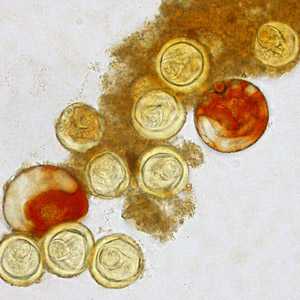
Figure A: Eggs of Bertiella sp. liberated from proglottids. The proglottids were shed from a human patient who had lived for a number of years in Africa. In several of these eggs, the pyriform apparatus can be easily seen. Images courtesy of Clinipath Pathology, Perth, Australia.

Figure B: Eggs of Bertiella sp. liberated from proglottids. The proglottids were shed from a human patient who had lived for a number of years in Africa. In several of these eggs, the pyriform apparatus can be easily seen. Images courtesy of Clinipath Pathology, Perth, Australia.

Figure C: An egg of Bertiella sp. liberated from a gravid proglottid. The arrows point to the hooklets.

Figure D: An egg of Bertiella sp. liberated from a gravid proglottid. The arrows point to the hooklets.
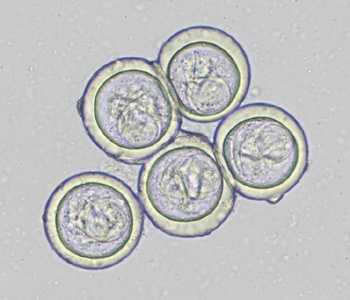
Figure E: Eggs of Bertiella sp. liberated from gravid proglottids. Image courtesy of the National Public Health Surveillance Laboratory, Vilnius, Lithuania.
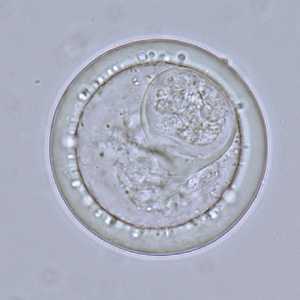
Figure F: Eggs of Bertiella sp. liberated from gravid proglottids. Image courtesy of the National Public Health Surveillance Laboratory, Vilnius, Lithuania.
Proglottids and scoleces of Bertiella spp.
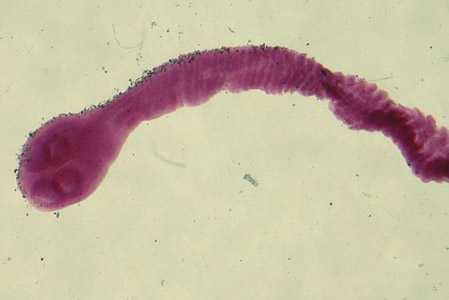
Figure A: Scolex of Bertiella studeri. Image courtesy of Richard Bradbury.

Figure C: Partially-cleared proglottids of Bertiella sp. In this image, many eggs can be seen through the proglottids. Image courtesy of the National Public Health Surveillance Laboratory, Vilnius, Lithuania.
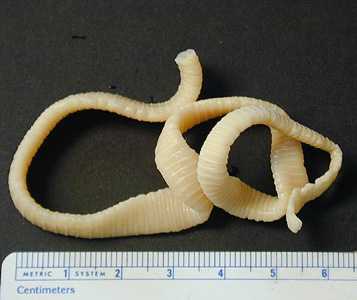
Figure B: Proglottids of Bertiella sp.
Laboratory Diagnosis
Diagnosis is made by the finding of proglottids or, less-commonly, eggs in stool. The eggs are characteristics and can be liberated from gravid proglottids.
Treatment Information
Limited data are available about treating Bertiella infection in humans. Various medications have been used with anecdotal success for treatment of individual patients. One such medication is praziquantel,* which is commonly used to treat infections with other intestinal tapeworms.
* This drug is approved by the FDA, but considered investigational for this purpose.
DPDx is an education resource designed for health professionals and laboratory scientists. For an overview including prevention and control visit www.cdc.gov/parasites/.
- Page last reviewed: May 3, 2016
- Page last updated: May 3, 2016
- Content source:
- Global Health – Division of Parasitic Diseases and Malaria
- Notice: Linking to a non-federal site does not constitute an endorsement by HHS, CDC or any of its employees of the sponsors or the information and products presented on the site.
- Maintained By:


 ShareCompartir
ShareCompartir